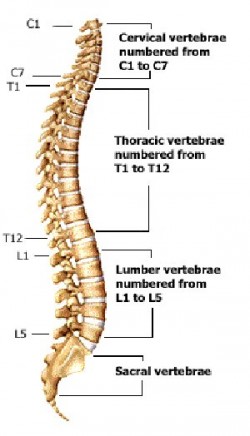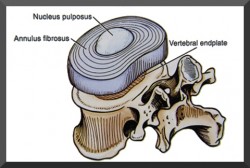 Your spine acts as the primary physical support for your body. It is composed of 33 separate vertebrae with joints between each of them that are flexible and allow you to stand, bend over, and twist, etc. The bony vertebrae enclose and help protect the spinal cord, which is connected directly to the brainstem. A healthy spine is flexible and strong, and contributes to strong muscles and bones. However, strain and injuries to the spine or disease can cause problems which result in pain, inflammation and restricted movement.
Your spine acts as the primary physical support for your body. It is composed of 33 separate vertebrae with joints between each of them that are flexible and allow you to stand, bend over, and twist, etc. The bony vertebrae enclose and help protect the spinal cord, which is connected directly to the brainstem. A healthy spine is flexible and strong, and contributes to strong muscles and bones. However, strain and injuries to the spine or disease can cause problems which result in pain, inflammation and restricted movement.
As with most bones in our body, the spine continues to develop into adulthood, gradually adapting itself from a C-shape when we are infants, which is suitable for crawling, to an S-shape, which is the natural shape for two-legged walking. The natural curves in the spine, called the primary and secondary curves, serve to help cushion impact during movement, absorb shock, preserve balance, and allow range of motion.
There are three main curves in the spine that are the cervical curve (the neck region), the thoracic curve (the upper back) and the lumbar curve (the lower back). Typically, there are 7 cervical vertebrae, 12 thoracic vertebrae, 5 lumbar, 5 sacral and 4 coccygeal (We say typically because certain people may have an extra vertebra. This is simply an anomaly and does not usually create any problems with the spine). The sacral and coccygeal (what most people refer to as the tailbone) are the lowest vertebrae in the spine, below the lumbar area. Good muscle tone is important to help maintain proper posture which is important in keeping good spinal alignment. It is important to put effort into maintaining proper posture by training our bodies to walk, stand, lie, and sit such that the lowest possible amount of strain is placed on our spine, muscles, ligaments and discs.
 Between each of the cervical, thoracic and lumbar vertebrae are intervertebral discs which act like cushions to help absorb energy but they also play an important role in the motion and function of the vertebral joint. The outer fibers of the disc are made up of criss-crossed (annulus) fibers which make it very strong. The middle of the disc is called the nucleus pulposus and is a jelly like substance, this is what is involved when you have a disc bulge or herniation. Discs are fluid filled and without proper movement and function can become brittle and cracked allowing the nucleus material to bulge or herniate. As Gonstead doctors, much of our focus is on the discs and how they affect and are affected by subluxations in the spine.
Between each of the cervical, thoracic and lumbar vertebrae are intervertebral discs which act like cushions to help absorb energy but they also play an important role in the motion and function of the vertebral joint. The outer fibers of the disc are made up of criss-crossed (annulus) fibers which make it very strong. The middle of the disc is called the nucleus pulposus and is a jelly like substance, this is what is involved when you have a disc bulge or herniation. Discs are fluid filled and without proper movement and function can become brittle and cracked allowing the nucleus material to bulge or herniate. As Gonstead doctors, much of our focus is on the discs and how they affect and are affected by subluxations in the spine.
As stated earlier, your spine encases and protects you spinal cord. Nerves that go to every single part of you body exit the spinal cord through holes created between the vertebral joints. Damage to the spinal cord can cause numbness and loss of motor function. Injury to the cervical area can cause tetraplegia (also known as quadriplegia), while injury to the thoracic or lumbar area may result in paraplegia, or loss of the use of the legs and trunk. Injury or inflammation to the smaller nerves exiting the spinal cord can create an array of problems and are most noticeable by pain, numbness, tingling, dysfunction etc. of the area or organ the nerve innervates.
There are several common spinal disorders, many that are caused simply by bad posture and subluxations of the vertebrae. Some have to do with what is called lordosis or kyphosis, which refers to the natural curves of the spine. In some cases, these curves are greater than they should be and in other cases less than they should be. For example, many times we see patients that have a hypolordosis in the cervical spine, in other words, the curve in their neck has become straight and in some cases curving the wrong way. Scoliosis occurs when there is a mild side-to-side curvature in the spine. Slight curves of less than 20 degrees do not usually present health or medical problems. Moderate curves usually need treatment because they can significantly limit physical activity. Thankfully, chiropractors are equipped to treat these kinds of conditions.
This is a very simple and basic understanding of the spine but should give you a good understanding of the anatomy involved. If you or someone you know could use chiropractic care, call you chiropractor in Tulsa, Dr. Schluter. We are more than happy to sit down and talk to you about your condition and make sure you understand it fully.




